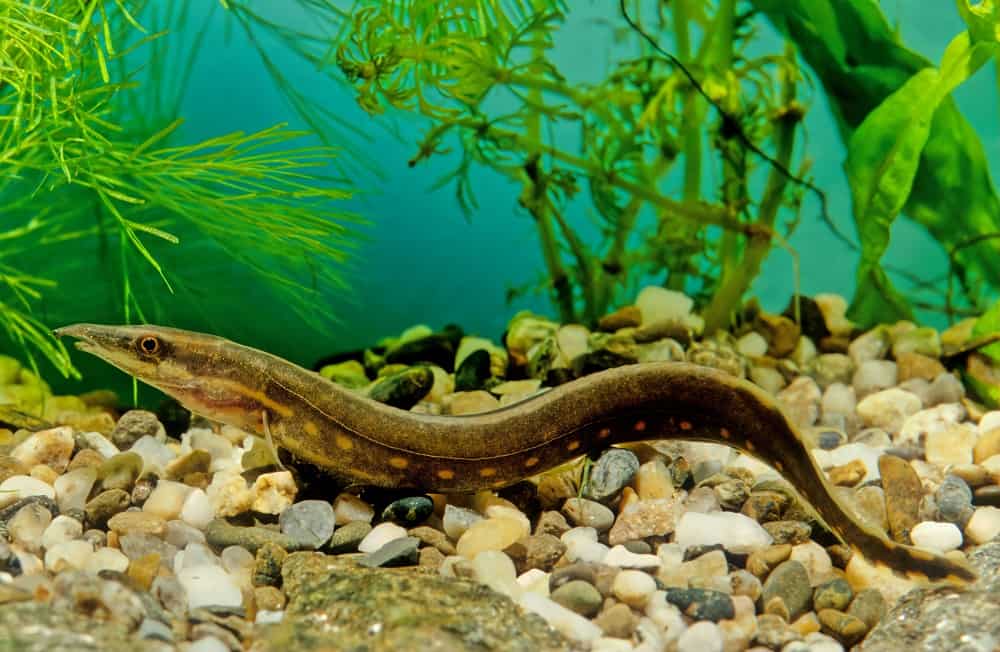The fire eel, also known as Mastacembelus erythrotaenia, is an omnivorous freshwater fish that’s one of the largest species of spiny eels.
The bottom-dwelling fish is native to South-East Asia and is mainly found in slow-moving muddy rivers and lakes. This is somewhat understandable given the fact that one of its favorite activities is to bury itself in the riverbed. They’re also commonly found in the aquarium trade.
While fire eels may resemble “true” eels in terms of their snake-like body and painted snout, there’s actually nothing that links the two.

Instead, fire eels belong to a group of fishes called spiny eels which also includes zig-zag and peacock eels. These eels get their name from the selection of small dorsal spines that precede their dorsal fins.
In Asia, locals eat all kinds of eels, therefore fire eel are highly prized. This attitude however, isn’t shared among young fisherman and aquarsits who are fully aware of the problems that fire eels can cause with their dorsal spines.
While the spines themselves aren’t poisonous, the slime they produce is. Therefore, if a fire eel has bitten you, make sure you apply some antiseptic to the wound as soon as possible. This is why it’s best to be careful around the fish and try to avoid touching it.
Tank Size
If you’re thinking of keeping one adult species of fire eel in a tank, you’ll need a tank larger than 77 gallons (350 litres).
Furthermore, it’s recommended to have a 2 inch (5 cm) thick sandy bottom with plenty of shelters made of flower pots, snags, coarse and floating tank plants. This creates shadow at the bottom of the tank which is perfect for fire eels to hide in.
It’s best to avoid adding tank plants with roots and use floating ones instead. This is because fire eels love to bury themselves in the sandy, shadowed bottom of the tank, and unsurprisingly, they don’t care too much about the tidiness of their surroundings.
It’s more than likely that they’ll dig up and damage the roots of any traditional tank plants.
As is the case with keeping most fish inside an aquarium, it’s important to make sure there are no significant cracks in the tank. This is particularly important with fire eel as they can breach the tank through the tiniest of slits.
Since fire eels demonstrate a fair amount of aggression towards its kind, it’s best to keep them in their own tank and away from each other. However, they can have the company of some peaceful and active tank fishes.
Tank Mates & Same Species Tanks
Fire eel is generally timid and will ignore its tank mates if it can’t eat them. They do, however, eat small fishes. With this in mind, the best tank mates for fire eel are peaceful fish that are too large to be eaten. For example, medium to large barbs are ideal.
As mentioned previously, fire eels demonstrate aggression towards its kind and this is why it’s strongly recommended not to keep a couple in one tank. What’s more, there isn’t too much point considering how difficult it is to obtain the fish eggs.
Water Parameters
Due to the fact that fire eels are typically found in large lowland rivers, they’re far less demanding with regards to water chemistry compared to many of the more habitat-specific species.
A temperature of between 24-28℃ (75-82℉) and a pH of 6.5-7.5 are the optimal tank water conditions. The water should also be slightly hard at 6-12 GH.
Furthermore, power aeration, filtration and water renewal (usually up to a quarter of the total tank volume) are essential when keeping a fish like a fire eel. They also like some form of water flow in a tank.
Diseases
It’s important to always be on the lookout for any diseases your fire eel may have picked up. Notable changes in behavior or markings on their body are usually the biggest indicators that something’s wrong. As with any disease, the earlier you notice the issue, the quicker you’ll be able to respond.
Most of the common freshwater diseases that can affect your other tank fish can also affect your fire eel. The most well-known is Ich – a parasite that causes white spots to appear across a fish’s body.
Some bacterial diseases are more difficult to treat than others, so taking preventative measures is always a good idea. This means putting extra effort into considerations like increasing the frequency of partial water changes to keep the environment as clean and safe as possible.
Infections in fire eels are often caused by rough substrate, which is hardly surprising considering they spend so much of their time burying into a tank’s coarse substrate.
Large grains can easily scratch them, often leading to an eel developing a white nose. To avoid this, create a thick layer of a sandy and muddy substrate in your tank.
Food & Diet
In a home aquarium, fire eels recognize their owners and will be confident enough to take food from their hands. You can feed them a wide selection of live food, including tubifex, bloodworms, and small fishes. They’re also happy to munch on dry and frozen food too.
In their natural habitat, fire eels are predators and prey on insect larvae, small crabs, snails, and worms. Fully grown fish eel can also feast upon larger food like fish, mussels, earthworms, and live shrimp.
One important thing to keep in mind is that because the fire eel is so large, it requires a considerable amount of nutrition, so make sure you’re feeding it enough. You’ll see the benefits of thorough nutrition in your fire eel’s increased activity and more intense hues.
Lifespan
In a home aquarium, fire eel tend to grow to around 20 inches (60.8 cm) and live for up to ten years with proper care and good water conditions. Fire eel in their natural habitat however, grow to 3.3 feet (roughly one meter) and live twice as long – up to 20 years.
Appearance & Size
The appearance of a fire eel is one that closely resembles that of a “true” eel, with an elongated dark brown body covered in small scales and four stripes placed laterally. These stripes have orange or red hues, as well as spots that vary depending on the condition of your tank and the age of the eel.
The fire eel’s dorsal fin is divided into two parts, and it has a fully developed tail. Both the dorsal and anal fins are long and narrow and located close to the end of the caudal fin. It’s worth noting that fire eels have no abdominal fins.
In terms of size, it’s reasonable to expect your fire eel to grow up to 20 inches (60.8 cm) in length. This would be twice as long if they were in their natural habitat in the wild.
Behavior & Temperament
The fire eel is relatively under-demanding, but the fact that it’s a large predator fish imposes restrictions on keeping it inside a tank. You’ll need an extremely spacious tank, as well as tank mates that are large enough, so the fire eel won’t treat them as food.
Fire eels are nocturnal fish, so during the day they’ll hide under the snags and stones, burying themselves in the tank bottom substrate. As a result, all you’ll be able to see is their eyes and a snout.
To give your fire eel enough hiding space, try to have plenty of driftwood, large rocks, and even some PVP pipe in the tank. It also helps to keep the lighting dim.
As mentioned earlier, all fire eels enjoy digging and burrowing in the bottom of tanks, so go easy on rooted aquatic plants or they’ll uproot them and damage your substrate.
Breeding
If you’re thinking about attempting the daunting task of breeding fire eels in captivity, we recommend against it. Firstly, fire eels struggle to get on with one another when placed together in a tank, so bringing them together for mating will be tumultuous to say the least.
Furthermore, you’ll need a huge amount of space in your home for both a regular tank and a breeding tank.
If that isn’t enough to put you off, it’s also extremely difficult to recreate the environmental conditions in the wild necessary for spawning, so therefore, any attempts to breed in captivity are likely to be fruitless.
During the breeding process, the male pursues the female until he catches her, at which point he squeezes between 700 to 1,000 eggs out of her. Adult fire eels are known to eat their own eggs, so if you’re trying to breed, it’s a good idea to remove the parents immediately after the eggs have been laid.
Gender Differences
Female fire eels are typically paler in coloring than their male counterparts and often larger in size too. It’s usually easier to discern between male and female fire eels during breeding when the male’s bright color becomes even more intense.








